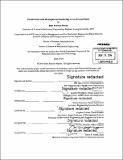| dc.contributor.advisor | Bradley Morrison and Bruce Cameron. | en_US |
| dc.contributor.author | Marsh, John Andrew, S.M. Massachusetts Institute of Technology | en_US |
| dc.contributor.other | Leaders for Global Operations Program. | en_US |
| dc.date.accessioned | 2014-10-08T15:27:08Z | |
| dc.date.available | 2014-10-08T15:27:08Z | |
| dc.date.copyright | 2014 | en_US |
| dc.date.issued | 2014 | en_US |
| dc.identifier.uri | http://hdl.handle.net/1721.1/90755 | |
| dc.description | Thesis: M.B.A., Massachusetts Institute of Technology, Sloan School of Management, 2014. In conjunction with the Leaders for Global Operations Program at MIT. | en_US |
| dc.description | Thesis: S.M., Massachusetts Institute of Technology, Department of Mechanical Engineering, 2014. In conjunction with the Leaders for Global Operations Program at MIT. | en_US |
| dc.description | Cataloged from PDF version of thesis. | en_US |
| dc.description | Includes bibliographical references (page 51). | en_US |
| dc.description.abstract | Aircraft are complex machines consisting of tens of thousands of parts and assemblies. Due to special engineering requirements, processes, and materials, the lead time for many of the parts can be several months resulting in a long aircraft lead time. During periods of high demand long aircraft lead time is less of a concern since manufacturers often have a large backlog, which is greater than the lead time, allowing them to build the aircraft to order. However, during periods of low demand, manufacturers may need to forecast demand and make the decision to start building aircraft before having a committed customer order. The longer the lead time of the aircraft, the further out into the future the manufacturer has to forecast, which leads to greater uncertainty and variability. In this environment it becomes essential to focus on lead time reduction to allow for better forecasting. Shorter aircraft lead times also have the added benefits of increasing flexibility in production and capacity planning, and lowering inventory holding costs and work in process. Reducing aircraft lead time can often be a difficult task. However, a structured approach to lead time reduction can be very powerful. This paper presents a framework for lead time reduction that is composed of a lead time reduction chart, which provides the correct areas of focus; a strategy flowchart, which identifies the components, strategies, and actions that can be implemented to reduce aircraft lead time; and a summary of reduction strategies that are focused on low rate, complex parts. While the framework is detailed toward aircraft lead time reduction, it is general enough to apply to most supply chain and manufacturing situations. This framework was used during a six month aircraft lead time reduction study at Sikorsky Aircraft Corporation, and analysis reveals that this structured approach was effective at reducing average aircraft lead time by 12.7%. | en_US |
| dc.description.statementofresponsibility | by John Andrew Marsh. | en_US |
| dc.format.extent | 52 pages | en_US |
| dc.language.iso | eng | en_US |
| dc.publisher | Massachusetts Institute of Technology | en_US |
| dc.rights | M.I.T. theses are protected by copyright. They may be viewed from this source for any purpose, but reproduction or distribution in any format is prohibited without written permission. See provided URL for inquiries about permission. | en_US |
| dc.rights.uri | http://dspace.mit.edu/handle/1721.1/7582 | en_US |
| dc.subject | Sloan School of Management. | en_US |
| dc.subject | Mechanical Engineering. | en_US |
| dc.subject | Leaders for Global Operations Program. | en_US |
| dc.title | Framework and strategies for reducing aircraft lead time | en_US |
| dc.type | Thesis | en_US |
| dc.description.degree | M.B.A. | en_US |
| dc.description.degree | S.M. | en_US |
| dc.contributor.department | Leaders for Global Operations Program at MIT | en_US |
| dc.contributor.department | Massachusetts Institute of Technology. Department of Mechanical Engineering | |
| dc.contributor.department | Sloan School of Management | |
| dc.identifier.oclc | 891370270 | en_US |
